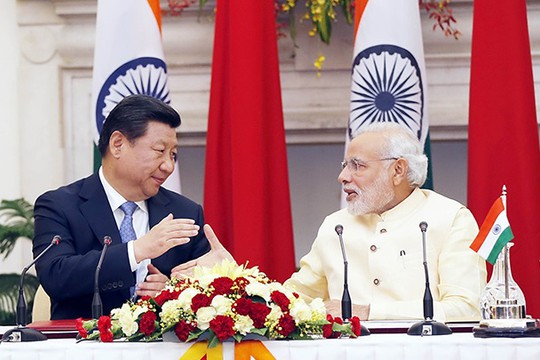India's Prime Minister Narendra Modi and China's President Xi Jinping.
Photo: people.com.cn
A flurry of high-level meetings in recent weeks hinted that Indian and Chinese leaders were exploring a way out of a four-year impasse on the Himalayan frontier. The Ministry of External Affairs of India (MEA) finally announced a breakthrough on the border standoff. New patrolling arrangements have been agreed to that would lead to a disengagement of military forces from the forward areas pertaining to the key friction points along the India-China border. It is expected that this process would eventually lead to a de-escalation and the return of military forces to their peacetime stations, thus, marking the end of the crisis, comments Zorawar Daulet Singh, an award winning author and strategic affairs expert based in New Delhi.
The timing of this resolution is interesting for it is linked to major upheavals in world politics and economics that have shaped the broader context underlying the sudden success of Indian and Chinese negotiators in breaking the Gordian knot.
A rapidly evolving international order has prompted policymakers on both sides to imagine ways to transcend the stalemate. A key impetus is India-China relations are remarkably quiet compared to the turbulent and violent changes in the international system in the past few years. Ironically, even the abnormal state of India-China relations has been more peaceful, more stable, and more predictable than the relationship between other great powers. The US and Russia are embroiled in a devastating proxy war, which in many ways is worse than their ties during the Cold War. The US and China are mired in intense mutual distrust and uncertainty.
A key factor leading up to a reassessment in India’s calculus has been whether the US can continue to be leveraged to sustain the abnormal state of India-China relations.
If it was conventional wisdom at one point in time to assert that the US held the keys to managing India’s China problem, this assumption is no longer obvious today. Washington has made it apparent that it sees India more as a useful instrument in a future confrontation with China than as a major power with legitimate geopolitical interests and aspirations of its own.
This patronising attitude has unsettled many Indians who worry not just about the US being unable to back up the tough talk on China should a serious clash erupt in the Himalayas, but that India might find itself drawn into a deadly US-China military conflict in the Western Pacific region. To further complicate matters, the US has lost its military supremacy vis-à-vis China to enforce a security architecture in Asia without Beijing’s consent. The future incumbent in the White House cannot change these fundamental realities.
If the US cannot alter the balance of power in India’s favour and risks bringing its unpredictable baggage and security flashpoints with China to negatively impact India-China ties, Indian policymakers must geopolitically insulate India-China ties to the maximum extent possible.
This is a hard security argument. India’s national interests demand a management of the China relationship that is in tune with a rapidly changing international environment.
The second factor that has led to a clear-eyed reassessment of the India-China relationship is the rapidly changing geoeconomic environment along with the tactical and even strategic necessity to reshape economic interdependence with China.
Globalisation that accompanied the previous phase of India-China relations was of a different character. National power accretion was not the central preoccupation of the economic policies of most rising powers. The focus was primarily on growth regardless of its qualitative aspects and regardless of its impact on industrial, technological advancement and employment generation. The collective West was also the dominant economic force in the world economy. However, that open and unequal international economic order is being displaced over the past decade by a fragmented, competitive and uncertain globalisation. Faced with a global power transition, major powers are resorting to industrial strategies, trade wars and economic sanctions – instruments that were prevalent in previous eras but had been thought to be obsolete in the ‘flat world’ model of the early 2000s.
With the West abdicating its role, India and China have positioned themselves as system stabilisers. That is one key reason to attempt to rediscover overlapping interests and pursue collaboration in defined areas with China. Imagine these areas as the future public goods through which economic interdependence in a multipolar world will flourish. Of course, there are other partners in this process of safeguarding and steering globalisation in an inclusive non-western direction. BRICS is the most obvious multilateral cooperation format today, but other options could emerge in the future.
Interlinked with the emerging global economic order are ground realities of trade, technology and investment flows.
China’s dominant position in global industry and trade make it an indispensable factor in any rising power’s economic policies.
As Modi and Xi finally break the ice at the BRICS summit this week in Kazan, Russia, the India-China relationship is poised for change. The crosstalk of the past four years, with diametrically opposing concepts regarding a détente, needs to be transcended by a dynamic approach that is realistic in its security goals, ambitious in its world order vision, positive-sum in its geoeconomic intent, and politically confident enough to account for the core national interests of both sides. Given the prevailing international conditions, the logic for a responsible and constructive competition between India and China is within reach and can be fleshed out in serious bilateral negotiations.
read more in our Telegram-channel https://t.me/The_International_Affairs

 11:39 23.10.2024 •
11:39 23.10.2024 •























